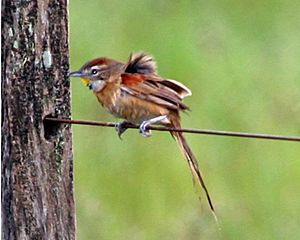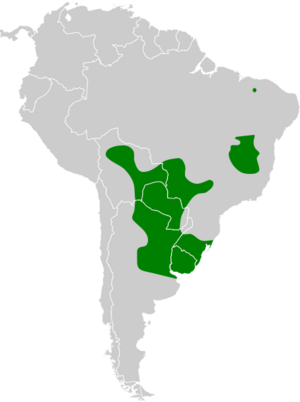Chotoy spinetail facts for kids
Quick facts for kids Chotoy spinetail |
|
|---|---|
 |
|
| Conservation status | |
| Scientific classification | |
| Genus: |
Schoeniophylax
|
| Species: |
phryganophilus
|
 |
|
The chotoy spinetail (Schoeniophylax phryganophilus) is a cool bird from the ovenbird family. It lives in South America, in countries like Argentina, Bolivia, Brazil, Paraguay, and Uruguay. This bird is known for its unique look and interesting sounds.
Contents
What Kind of Bird is the Chotoy Spinetail?
The chotoy spinetail is a special bird that has its very own group, called Schoeniophylax. It used to be grouped with other birds, but scientists decided it was unique enough to have its own genus. It's like how you might be part of a big family, but you also have your own unique name! This bird is a close relative of the white-bellied spinetail.
There are two main types, or subspecies, of the chotoy spinetail. The first is S. p. phryganophilus, which is the most common. The second is S. p. petersi.
What Does the Chotoy Spinetail Look Like?
This bird is about 20 to 22 centimeters (8 to 8.5 inches) long. It weighs about 15 to 22.5 grams (0.5 to 0.8 ounces). Both male and female chotoy spinetails look the same.
They have a white stripe above their eyes, called a supercilium. Their cheeks are light brown. The top of their head is chestnut brown with some streaks. Their back is sandy brown with darker streaks. Their lower back and tail feathers are light brown.
Their wings are mostly light brown, with a chestnut patch on the shoulder. Their tail is long and light brown, with dark lines down the middle of each feather.
One of the most unique things about this bird is its throat. Its chin and upper throat are bright yellow! Below that, it has a clear black square patch, surrounded by white.
Their chest is a pretty apricot color, fading to a buffy white on their lower chest and belly. Their legs and feet are light gray. Young birds look similar but have less clear streaks and a brownish head. The S. p. petersi subspecies is a bit smaller than the main one.
Where Do Chotoy Spinetails Live?
The most common type, S. p. phryganophilus, lives in many places. You can find it in eastern Bolivia, parts of Brazil, most of Paraguay, northeastern Argentina, and almost all of Uruguay.
The other type, S. p. petersi, lives in a few separate areas in northeastern Brazil.
These birds like open or partly open areas. They live in grassy savannas with trees. They also like forests and thick bushes near rivers. You can find them in dry woodlands and at the edges of marshy areas. They live from sea level up to about 500 meters (1,600 feet) high.
How Do Chotoy Spinetails Behave?
Staying in One Place
Chotoy spinetails do not migrate. They stay in the same areas all year long.
What Do They Eat?
These birds mainly eat arthropods, which are like insects and spiders. They usually look for food alone or in pairs. They pick their prey off small branches and leaves. They usually forage close to the ground, within about 1 meter (3 feet).
How Do They Raise Their Young?
Chotoy spinetails breed in the spring and summer in the Southern Hemisphere. This is usually from late September to January. They are thought to stay with one partner.
Their nest is quite interesting! It's a big ball made of thorny sticks. It has a tunnel-like entrance on the side. Inside, the tunnel and the main room are lined with soft plant material. They usually build their nests in a bush or small tree, about 3.5 meters (11.5 feet) off the ground. Sometimes, they build them much higher.
A female chotoy spinetail usually lays three to six eggs, but most often it's four or five. The eggs hatch after about 15 to 16 days. The young birds leave the nest about 13 to 14 days after they hatch.
What Do They Sound Like?
The chotoy spinetail has a very unique song. It's a series of low-pitched "cho" notes. It sounds like it comes from a much bigger bird! People have described its song as "rrrrtooo chicheetitichichicheecheychachochoochew". Its call is a quick "sreepsreeptrrit".
Is the Chotoy Spinetail in Danger?
The IUCN (International Union for Conservation of Nature) has said that the chotoy spinetail is a species of "Least Concern". This means they are not currently in danger of disappearing. They live in a very large area, and their population seems to be stable.
Scientists haven't found any big threats to these birds right now. They are considered fairly common. They are also quite good at adapting to different places, even living in areas that have been changed by humans.



